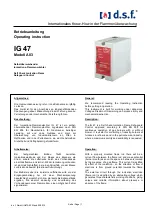
MACHINES AND
ACCESSORIES
Page 11 of 17
7.2 Pressure Release
To lower the piston rod on the hydraulic cylinder,
decrease the pressure inside the circuit by opening the
vent valve and slowly turning the knob anti-clockwise
(Figure 8)
Figure 8 – Control knob.
8 MAINTENANCE
The purpose of this chapter is to provide the timing and maintenance procedures required to
maintain the
Hydraulic Pump.
Maintenance and repairs must be performed by qualified personnel.
INTERVENTION
Frequency
Daily
Weekly
Monthly
1.
General visual inspection
X
2.
Check legibility of plates
X
3.
Check for the absence of oil leaks
X
4.
General cleaning
X
5.
Lubrication and greasing
X
6.
Check the hydraulic oil level and top up
X
7.
Bleed air from the circuit
If necessary
8.
Replace the hose
By the expiration date
1.
General visual inspection:
check the general condition of the pump, if there are any
damaged or missing parts.
2.
Check the clear visibility and legibility of labels:
the identification label on the
pump must be perfectly visible and legible. It is necessary to keep it clean and ask for
a replacement if it becomes illegible.
3.
Verify the absence of hydraulic oil leaks:
there can be no measurable accidental
loss in the hydraulic circuit, except for slight moisture insufficient to form a drop.
4.
General cleaning:
cleaning is necessary to free the structure and moving parts from
the accumulation of dust, dirt and stains caused by excess lubricants. Cleaning should
be done with the use of means, equipment and detergents or solvents commonly used
in the cleaning of industrial equipment.
5.
Lubrication and greasing:
it is necessary to grease the moving parts of the pump,
such as pins, hinges and levers on the pumping system.
6.
Check the hydraulic oil level and top up:
Check the oil level and if necessary top up
with hydraulic mineral oil.
place the pump in a horizontal position;
fervi.com



































